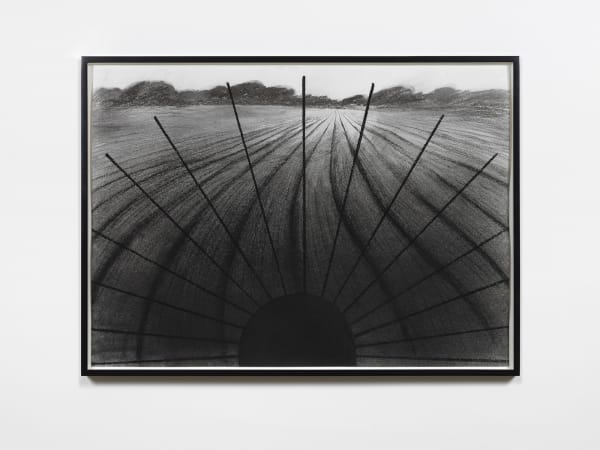Nikita Kadan: Victory Over the Sun
François Ghebaly New York is proud to present Victory over the Sun by Nikita Kadan, the Ukrainian artist’s first solo exhibition in the United States.
Nikita Kadan has developed over the last twenty years a singular oeuvre in the form of drawings, photographs, posters, and monumental installations. Emerging from an activist tradition, Kadan’s individual practice reflects on the politics of memory, and the relationship between the idealist ethos of modernity and the reality of capitalism. Kadan draws his inspiration from history, revealing episodes that have been distorted, forgotten, or deliberately erased from the official narrative of his country. After a post-Soviet period “characterized by historical amnesia,” explains the artist, the last decade of Ukrainian history has been marked by a “war of memory” where contradictory historical symbols and judgements occupy public consciousness.
Victory over the Sun refers to a 1913 Futurist opera of the same title that premiered at Luna Park in Saint Petersburg. Kadan observes, “it was an accumulation of the strongest forms of avant-gardes of the time, Russian as well as Ukrainian.” Stage designer Kazimir Malevich and librettist Aleksei Kruchenykh were “appropriated by Russia and made part of their official history by this empire yet they were born in Ukraine”–Malevich in Kyiv, Kruchenykh in the Kherson region. The plot of the opera concerns a group of protagonists who want to destroy reason by disposing of time and capturing the sun. But what kind of victory can now be achieved today in Ukraine? What kind of sun can be captured?:
The futurist intention was always to enter the future in a very voluntarist way. When I look at this avant-garde creation today, from the ruins that define our reality in Ukraine, I see a struggle of the past with the present but without a future. It is a struggle between something ultraconservative, the Russian Federation, and some sort of current liberal international normality, Ukraine.
Many of the works in Victory over the Sun possess what the artist calls an “eschatological optimism.” “They are about terrible things but I also try to get some source of energy from this catastrophe happening.” A new version of Kadan’s Tiger Leap series is presented here, replicating the improvised weapons created from tools by factory workers in a failed 1905 uprising in Horlivka, an industrial city near Donetsk. Though the revolt was violently subdued by the Russian army, it became a crucial part of the 1905 revolution and a turning point for the worker’s movement in the Donbass region. The work takes its name from Walter Benjamin’s concept of the “tiger leap,” the idea that any genuine revolution is not only a leap towards the future but also “a tiger’s leap into the past”–that is to say, a dialectical leap towards a moment in the past “filled by the presence of the now” (Benjamin, On The Concept of History). “Can we pick these weapons and continue the struggle?,” wonders Kadan. “This spear is gigantic because we have to struggle with the weapons of giants now. We are facing a historical challenge.”
Exhibition (2018) consists of fragments of melted glass that the artist took from the windows of a burned school in Stanitsa Luganskaya, Lughansk, which is currently occupied by Russia. A photo of the school is projected on the gallery’s far wall beside framed prints of corresponding architectural illustrations from the 1980s. The neon artwork, Private Sun (2022), is part of a series that the artist began in 2013 and refers to the standard Soviet “sun window grate,” which features radiating bars like the rays of the sun. Today, the grate design is ubiquitous in the post-socialist urban environment of contemporary Ukraine. “It represents a field of tension between oppression and dreams, impoverished everyday life and its utopian horizon.”
The gallery’s front room houses charcoal drawings that the artist began at the start of the Russian invasion. In one drawing, a black plastic bag is “a symbol for the devaluation of human lives during the war”–bodies quite literally being placed in garbage bags. In another, the sun rises not in the sky, but from black soil. Untitled (2022) shows an underground passageway beneath Kyiv’s Obolon Station, which was turned into a bomb shelter. “It represents darkness, historical darkness which comes after the Victory over the Sun. But this darkness ‘shines’ too. It’s a symbol of this eschatological optimism. It helps you to survive.”
Nikita Kadan (b. Kyiv, Ukraine, 1982) is a member of the artist group R.E.P. (Revolutionary Experimental Space) and a co-founder of the curatorial group HUDRADA. He graduated from the National Academy of Fine Arts in Kyiv, where he studied monumental painting. He currently works in sculptural installation, graphic design, painting, and drawing, and frequently collaborates with architects, human rights activists, and sociologists. Recent solo exhibitions include PinchukArtCentre, Kyiv; Jerome Poggi Gallery, Paris; and MUMOK, Vienna. Recent group exhibitions include Miguel Abreu Gallery, New York; Parrotta Contemporary Art, Cologne; Castello di Rivoli Museo d’Arte Contemporanea, Turin; and Moderna Museet, Stockholm. Kadan was awarded the Special Prize at the 2014 Future Generation Art Prize, and was featured in the 2022 documenta fifteen exhibition in Kassel, as well as at the 2022 Venice Biennale. His works are held in public collections around the world, including the Centre Pompidou, Paris; Tate Modern, London; the National Art Museum, Kyiv; Pinakothek der Moderne, Munich; M HKA Museum of Modern Art, Antwerp; Frac Bretagne, Rennes, France; the Bundeswehr Military History Museum, Dresden, Germany; and Krasnoyarsk Museum Center, Krasnoyarsk, Russia.








